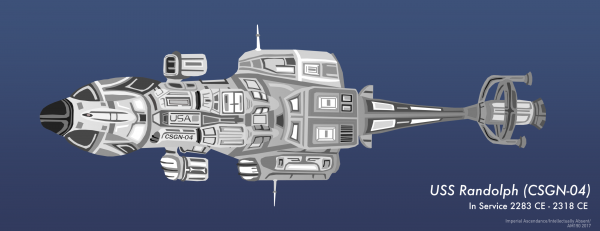BY LETTER
USS Randolph CSGN-04
History > 0030 to 0900 AT: Solsys Era > 130 to 400 AT: The Interplanetary Age
Technology > Application > Transportation > Ships > Classic Ships
Technology > Application > Transportation > Interplanetary Transport
Technology > Application > Weapons > Space-Based Weapons
Technology > Application > Transportation > Ships > Classic Ships
Technology > Application > Transportation > Interplanetary Transport
Technology > Application > Weapons > Space-Based Weapons
 Image from IA190 |
Specifications
Builder and completion date: Bernard Domodo Memorial Station (Luna-L3), 315 A.T.
Length: 189 meters
Mass: 11,200 tons
Propulsion: Fusion, one primary thruster with two sets of heavy maneuvering thrusters
Range: Interplanetary only
Armament: 50 'Starstrike' nuclear missiles; 24 'Bayonet' antimissile rockets; 2 neutral particle beam cannon; 2 antimissile defense lasers; 2 'Barbette' missile launchers in retract-mounts; plus two 'Rearguard' antiship missile launchers. Carries 2 heavy transatmospheric shuttles, 2 TAF (transatmospheric fighters, usually TAF-512) and 4-6 Utimechs (utility mecha).
Deployment and History
The USS Randolph was the first of a class of powerful (for the time) interplanetary cruisers built by the declining United States of America to counter the increasingly aggressive actions of the solar system by the Syndicate of Chinese Provinces, the South Asian Compact, and several powerful nationless corporations. Completed behind schedule and massively over-budget, the Randolph was the most powerful warship for over a decade. Her massive armament of nuclear missiles could threaten even hardened targets on planets, as well as any spaceship, domebase or station. The Chinese cruisers of the Ding Ruchang class built at Lin Zexu Station were thought to be a direct response to the Randolph class.From its first shakedown cruise the Randolph had an active and illustrious career. While picking up crew members in Earth orbit, the Randolph was directed to monitor the military standoff between Indonesia and New Zealand over seafloor mining rights and shot down several probes launched from the submarine Saliendra which came too close to American satellites. Just over a year later the Randolph and a Brazilian frigate rescued the survivors from the supply transport Barycenter and got a warm reception from the public on Juno. But the Randolph's primary claim to fame was the Xibalba Incident in 317 AT, when the ship faced down a fleet attempting to intervene in that trans-Plutonian planetoid's attempt to break away from the Russian Republic. The leader of the Xibalba Colony independence movement, Ivan Pieteras, heaped praise on Captain Moreno and the ship's crew for their daring action (although later it would be discovered that the United States Outer System Command orbiting Saturn had ordered the Randolph to stand firm because of an interest in the Ares-Olympia Corporation's massive holdings on Xibalba and throughout the Kuiper Belt, one of a series of scandals in the nearly-autonomous military bases of the outer solar system).
Obsolete and mothballed inside Phobos in 350 AT, the Randolph was finally purchased by the Star Pilgrim Corporation. Along with various other ships, it was gradually broken up for parts that, while old by military standards, were useful for assembling the civilian automated interstellar transports that would accompany the first wave of planned interstellar colonization missions.
The hull of the Randolph itself was part of a historical museum at Phobos until that satellite was mined out, and later during the Technocalypse the hull and the rest of the museum's exhibits were de-orbited over the Elysium spaceport by one of the warring Martian factions. A few of the Randolph's subsystems found their way into the convoy that followed the Star Pilgrim Corporation colonyship Utnapishtim-6 to Ross-128. There the transports were briefly used as barracks stations and finally scrapped.
Related Articles
Appears in Topics
Development Notes
Text by Aaron Hamilton
Initially published on 11 February 2001.
Initially published on 11 February 2001.






